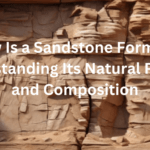Sandstone is one of the most popular natural stones in the world. Its distinct texture, durability, and aesthetic appeal make it an attractive option for a wide range of applications. Sandstone has been used for thousands of years to create ancient monuments as well as modern architectural masterpieces.
The primary question is what are sandstones used for and what applications they have. There are a wide range of building materials available, so it might be difficult to appreciate the sandstone’s actual value and versatility.
In this blog, Maroota Sandstone Quarry explains the sorts of sandstone, their advantages, how to maintain them, and their applications. Let’s explore this!
What is Sandstone?
Sandstone, a sedimentary rock, is made up primarily of sand-sized rock pieces or mineral particles. These particles are usually held together by natural binding agents like silica, calcium carbonate, or iron oxide.
Over millions of years, cementation and sand compaction have produced this result. Sandstone is commonly used in construction, landscaping, and architecture due to its strength and beauty. Its strength and inherent beauty are well known.
Formation of Sandstone
Over millions of years, the fascinating process of sandstone creation involves complex geological phenomena. The first process is sand formation, which occurs on beaches, deserts, and rivers.
Wind, water, or ice carry these sand particles towards the formation, which is mostly made up of quartz, feldspar, and other minerals until they settle down in layers.
These layers experience tremendous pressure as further sediments eventually cover them. This pressure compresses the sand particles, reducing the gaps between them.
In a process called lithification, silica, calcium carbonate, and iron oxide—natural cementing agents—precipitate from groundwater simultaneously, binding the grains together.
The ultimate product is a rock with different colors, textures, and compositions based on the minerals used in the cementation process and the original sand. The ultimate properties of sandstone are also influenced by elements such as the biological material present and the deposition environment.
Types of Sandstones
Sandstone, with its different types, showcases nature’s remarkable variety. Each sandstone is characterized by its unique composition, color, and size, making it suitable for various applications.
Charlotte
Charlotte Sandstone is a stalwart example of durability and aesthetic appeal in building materials. Its unique sedimentary layers, which were created over millions of years, provide interior and exterior structures with a unique texture.
For centuries, Charlotte Sandstone has been a popular material for architectural wonders due to its reputation for being weather-resistant.
It is perfect for outdoor uses including paving, wall cladding, and landscaping because of its resistance to erosion and capacity to maintain its natural beauty in a variety of climates.
Stirling
Stirling Sandstone, known for its timeless appeal and sturdy composition, is known to emerge from rocky quarries. With its warm, earthy colors and characteristically fine-grained texture, Stirling Sandstone elevates architectural landscapes all over the world.
This type of sandstone has a long geological history and is a popular choice for both interior and exterior cladding because of its remarkable weather resistance and longevity.
It can be used in a variety of architectural styles due to its natural color gamut, which includes rich browns and gentle creams.
Roman
Originating from ancient quarries, roman sandstone has a long history of durability and classic beauty. Its history extends back to the roman era, when it was widely used in iconic structures, including the Pantheon and Colosseum, displaying its durability and architectural significance.
Roman sandstone is recognized by its warm, earthy colors and fine-grained texture. Its timeless beauty goes well with both traditional and modern designs. Its inherent color range, which ranges from delicate creams to rich browns, gives exteriors, sidewalks, and interior accents depth and personality.
The rough beauty of Australia’s varied landscapes is captured by Australiana Sandstone. This sandstone species, which was extracted from ancient formations scattered over the continent, represents Australia’s natural history with its earthy tones and distinctive textures.
Australiana
The distinctive geological past of its origins is reflected in the color palette of Australiana Sandstone, which is known for its resilience and adaptability. It varies from warm ochre to chilly blue.
It is a well-liked option for outdoor uses such as pavement, landscaping, and wall cladding in both residential and commercial settings due to its weather resistance.
The Uses of Sandstones
Let’s discuss some of the uses of sandstone below:
Advantages in Construction
Sandstone’s advantages in construction include its strength, low maintenance, and durability requirements. Its resistance to weathering and erosion provides long-term performance, making it a cost-effective choice for a variety of applications.
Sandstone’s capacity to absorb heat helps improve indoor comfort.
Historical Uses
Sandstone has been a staple in construction for centuries. It has been used to construct historical monuments and buildings. Ancient civilizations such as the Greeks, Romans, and Egyptians used sandstone to build temples, elaborate carvings, statues, and so on.
Its simplicity of carving and durability make it excellent for retaining detailed artwork and inscriptions that have survived the effects of time.
Landscaping and Outdoor Uses
Sandstone is prized for its inherent beauty and adaptability in landscaping. It is utilized in sandstone landscape edging, stairs and walks, and ornamental elements. It can be carved into elaborate patterns to create sculptures and fountains that elevate any scene.
Interior Design
In addition to being suitable for outdoor use, this stone is also better for indoors. Its warm hues and distinctive textures produce a cozy yet fashionable atmosphere. Sandstone flooring is a popular option for homeowners seeking elegance and longevity.
It is particularly well-liked in kitchens and living areas. It is often used to create elegant fireplace surrounds that make it the centerpiece of a cozy living space.
Modern Applications
Sandstone is popular for decorative and structural purposes. Its colors, natural beauty, and textures make it suitable for exterior facades, flooring, paving, and interior walls. Because of its natural sealing qualities, sandstone’s thermal qualities also support energy-efficient construction designs.
Poolside Applications
This stone is a popular choice for pool surrounds due to its slip-resistant surface and ability to stay cool underfoot. The natural tones of this complement the aquatic environment beautifully.
Eco-Friendly Building Material
Sandstone is a naturally occurring material that is sustainable and kind to the environment. Its application in building lessens the carbon footprint connected with production processes and the need for synthetic materials.
The fact that sandstone often uses less energy to quarry and process than other building materials adds to its already great image as an environmentally friendly material.
Quarrying and Processing of Sandstone
Sandstone’s journey from quarry to its final applications involves several steps that ensure the highest quality and sustainability of this versatile material.
Quarrying
The process of this begins with identifying suitable sandstone deposits. Geologists conduct surveys to locate high-quality sandstone that meets specific color, durability, and texture. Once the site is found, the quarrying process involves:
- Clearing and Preparation: To reach the sandstone rock foundations, the quarry site is cleaned of plants and trash.
- Extraction: Blocks of large sandstone are removed by explosives, wire saws, or diamond-tipped blades. Both the size of the quarry and the hardness of the sandstone influence the method selection.
- Transport: Heavy machinery is used to move the harvested blocks from the quarry to processing facilities, minimizing stone damage.
Processing
During this process, the sandstone undergoes several steps to transform it into usable products:
- Cutting: The large blocks are cut into smaller blocks using a gang or circular saws. This stage determines the final size and shape of the sandstone pieces.
- Surface Finishing: The desired surface texture is achieved by finishing the slabs. The methods vary based on the intended use and include bush smashing, sandblasting, polishing, and grinding.
- Quality Control: Every piece is subjected to extensive quality inspections for uniformity in color, texture, and structural integrity. Defects are found and fixed if necessary.
- Packaging and Shipping: The completed sandstone products are then safely packed and sent to building sites, where they can be used for a variety of purposes.
Benefits of Selecting Sandstone
There are many benefits of sandstone:
- Eco-Friendly: It is an environmentally friendly option because it is a natural substance.
- Versatility: It can be carved, shaped, and cut to fit a variety of uses.
- Aesthetic Appeal: The organic hues and textures of sandstone give every project a certain charm.
- Durability: Sandstone is perfect for outdoor applications because of its exceptional durability and ability to tolerate harsh weather conditions.
- Low Maintenance: Sandstone is a long-term cost-effective choice because it takes little maintenance and is simple to clean.
How to Care for Sandstone
To maintain sandstone’s beauty in the long run, it’s important to maintain its beauty. Here are some tips that you can follow:
- Cleaning: Use a mild detergent and water to clean these surfaces. Avoid harsh chemicals that can erode the stone.
- Regular Inspection: Check for chips or cracks and care for them to prevent further damage.
- Sealing: Apply a high-quality sealant to protect it from stains and make it weather-resistant.
Conclusion
Sandstone’s natural beauty and adaptability have made it as a popular material for millennia. From attractive sandstone flooring to sturdy concrete block retaining walls, this natural stone has a wide range of artistic and practical applications.
Its exceptional combination of beauty, adaptability, and longevity makes it an asset in both modern and classic structures. Knowing the types, uses, and benefits of stones will help you choose the best one for your home.
To maintain your sandstone’s beauty for a long period, follow the maintenance guidelines. If this blog helps you, get this incredible natural stone to improve your surroundings and enjoy its advantages for many years to come.
FAQs
- Can kitchen countertops be made of sandstone?
Sandstone can be used for kitchen counters, but to prevent stains and scratches, it must be sealed.
- How long does sandstone last?
Sandstone may endure for decades or perhaps centuries with the right upkeep.
- What makes sandstone different from granite?
Although both granite and sandstone are durable, sandstone has a more organic and rustic appearance.
- Why is sandstone the best material for pool areas?
Sandstone’s non-slip surface and ability to remain cool under foot make it perfect for pool surrounds.
- Is sandstone a good choice for areas with lots of traffic?
Of course! Sandstone’s resilience makes it an excellent material for high-traffic areas like pathways and driveways.




